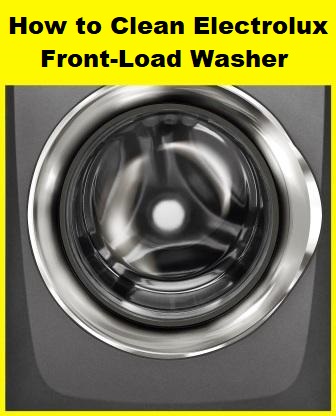Electrolux Washer Cleaning Front-Load Washer
Electrolux Washer Cleaning Front-Load Washer
Electrolux front-load washers are excellent for conserving electricity and water, but one drawback is that mould and mildew can quickly accumulate in the washer gasket. Additionally, soap scum and fungus growth are prone to occur in the detergent dispenser of the washer. The drum itself, as well as the drain hose and pump, will also benefit from routine deep cleaning.

1.Choose A Cleaning Product.
Your Electrolux washer may be cleaned using a variety of cleaning agents. Mold and mildew can be removed and germs can be killed with the use of bleach. The detergent dispenser and washer gasket need to be cleaned in the first two phases of washing your clothes.
Mold, mildew, and soap scum can all be removed using distilled white vinegar. The majority of bacteria can be killed by vinegar, but it is not as effective as bleach and other common household disinfectants. White vinegar can be used to clean the dispenser and door gasket, but bleach is preferred if you want absolute assurance that all the germs have been eliminated.
Important: Avoid combining bleach with vinegar or any other cleaning agent. A potentially lethal chlorine gas is produced when bleach and vinegar are combined.
Although it can harm rubber washer parts as well, white vinegar is OK to use to clean your washer as long as you don’t use it too frequently. White vinegar can be somewhat more efficient at removing tenacious detergent residue, mould, and mildew during the third stage of cleaning, which involves running a cleaning cycle.
Furthermore, you can clean your washer with baking soda.
The washer can also be cleaned with cleaning supplies purchased from a store. Store-bought washer cleaners work well for deep cleaning since they are carefully developed to get rid of mould, mildew, and soap scum while also eradicating germs and not harming your washer.
Your washer can be cleaned using any of these products. When cleaning the dispenser and gasket, use bleach for the best results. When cleaning the washer thoroughly, use a pre-formulated washer cleanser.
2. Wash The Detergent Dispenser.
Mold, mildew, and detergent residue commonly gather in the detergent dispenser. The quantity of residue and fungi that build up in the detergent dispenser can be decreased by routinely cleaning it.
It must be taken out of the washer to be cleaned. Additionally, you should clean the dispenser slot because it is frequently disregarded and serves as a perfect hiding place for mould and mildew.
Cleaning the detergent dispenser and the slot it came out of requires a solution of bleach and water or the use of another cleaning agent. After cleaning, put the dispenser back in the washer.
3. Clean The Door Gasket.
Another location where mould and mildew accumulate in front-load washers is the door gasket (the door seal). You will definitely see mould, mildew, and detergent residue when you look at the door gasket.
Wipe down the gasket using the bleach and water solution or another cleaning agent, making sure to get into all the crevices and crevices that you would not normally see. You might be able to help with the cleaning by using an old toothbrush.
After cleaning the gasket, be sure to clean the interior of the door as well.
Sprinkle some baking soda over the affected area if, after cleaning the gasket, there are still mould and mildew stains. When you come back after leaving the baking soda on for at least 10 minutes, the mould and mildew ought to be easier to remove.
Spraying the afflicted area with white vinegar or bleach mixed with water is an additional option. When you return, the mould and mildew ought to be easily wipeable if you also leave that for at least ten minutes.
The subsequent cleaning step should eliminate any mould and mildew that are still present.
4. Execute A Cleaning Cycle.
In order to clean the washer, some Electrolux models provide a cleaning cycle option. Run the longest cycle at the highest temperature if there is no cleaning cycle choice.
Verify the washer is empty before starting the cleaning cycle. Then, if you’re employing a washer cleaning product, such as Affresh washer cleaning tablets, adhere to the directions on the packet.
Half a cup of baking soda should be added to the drum if you’re using it.
If you’re using distilled white vinegar, put 1 cup of it in the detergent dispenser while emptying any extra vinegar into the drum.
If you’re using bleach, put ½ cup of bleach in the detergent dispenser and any extra bleach into the drum.
Do not combine vinegar and bleach, as was already indicated. Before adding your cleaning product to the washer, make sure to remove any residue left by bleach or vinegar if you have been using those cleaning agents.
Run a protracted, warm cycle after applying a cleaning product.
5 Wash The Washer’s Outside.
Clean the outside of the washer as you wait for the cycle to finish.
In Conclusion, Thewasher ought to be nearly new after the cleaning cycle is finished. Run a rinse and spin cycle to thoroughly clean the washer if you are worried about remaining chemicals or want to get rid of a vinegar or bleach stench.
If the washer is still dirty after the cleaning cycle, clean the interior by hand with bleach or vinegar and think about running another cleaning cycle, possibly this time experimenting with a different cleaning solution.
YOU MAY ALSO READ THIS
- Bosch Dishwasher E24 Error Code How to Fix It |
- Electrolux Kelvinator AC Error Code | Troubleshooting
- Chest Freezer not freezing | How Do Fix ?
- Fruit Fly Trap Using Homemade Trap Get Rid
- LG Washer UE Code 8 Step To Fix It UE Error Code
- Asko washing machines Error Codes
YOU MAY ALSO READ THIS

Ballu Air Conditioner Error Code

AmeriCool Air Conditioner Error Codes

Amana Washing Machine Error Code

AMANA Air Conditioner Error Codes

Acson Air Conditioner Error Codes

Aeronik Air Conditioner Error Codes

Aerotek Air Conditioner Error Codes




